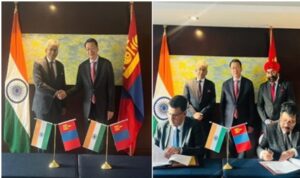India, Mongolia reviews bilateral ties.
Relevance
- GS Paper 2: Bilateral, regional, and global groupings and agreements involving India and/or affecting India’s interests.
- Tags: #upsc #indiamongolia #gspaper2 #bilateralties #ulaanbaatar.
Why in the news?
News: Yesterday in Ulaanbaatar, Secretary (East) of the Ministry of External Affairs Saurabh Kumar and Mongolian Minister of Education and Science L. Enkh-Amgalan held a productive meeting.
- In Ulaanbaatar, India had productive talks with the Mongolian Minister of Education and Science, L. Enkh-Amgalan.
- Discussions encompassed various aspects of bilateral collaboration, including education, information technology, skill development, and capacity building.
- Notably, they were also present at the signing ceremony for the construction contract of the India-Mongolia Friendship Secondary School.
- The status of bilateral relations, appraised Indian projects, and shared perspectives on reinforcing the India-Mongolia Strategic Partnership
- Their comprehensive discussions encompassed collaboration in diverse fields such as development partnership, education, information technology, hydrocarbons, renewable energy, security and defense, connectivity, minerals, and capacity building.
|
Mongolia ● Location: Mongolia is a landlocked country situated in East and Central Asia. It shares its borders with Russia to the north and China to the south, east, and west. ● It is the world’s second-largest landlocked country and the world’s most sparsely populated with the bulk of the population still engaging in traditional nomadic herding. ● The nation is sometimes referred to as the “Land of the Horse” and the “Land of the Eternal Blue Sky”. ● The Gobi Desert in the south and the towering Altai Mountains in the west are the two main geographical features of Mongolia. |
Key Facts about Mongolia
- Size and Population: It ranks as the world’s second-largest landlocked nation and is known for being the most sparsely populated country globally.
- Nomadic Traditions: The majority of the population maintains traditional nomadic herding practices. Mongolia is home to diverse ethnic groups, including Mongols, Kazakhs, and Tuvans.
- Nicknames: Mongolia is often referred to as the “Land of the Eternal Blue Sky” due to its vast, clear skies, and as the “Land of the Horse” due to the central role of horses in Mongolian culture.
- Geography: Mongolia’s landscape is characterized by the expansive Gobi Desert in the south and the imposing Altai Mountains in the west.
- Capital: Despite rapid modernization, the capital city, Ulaanbaatar, retains a strong traditional Mongolian identity, featuring numerous historical temples, monasteries, and cultural landmarks.
India-Mongolia relation
- India opened diplomatic ties with Mongolia in 1955, becoming the first nation outside of the Soviet Union to do so.
- A 1972 UN resolution seeking the recognition of the newly liberated Bangladesh was co-sponsored by Mongolia together with India and Bhutan.
- Despite fierce opposition from China and Taiwan, India has played a significant role in securing Mongolia’s admission to prominent international organizations, such as the United Nations and Mongolia’s admission to the Non-Aligned Movement.
- In 2015, after the Indian Prime Minister’s visit to Mongolia, this connection was elevated to a “strategic partnership” and was deemed a crucial aspect of the “Act East Policy.”
- Mongolia has openly expressed its support for India’s appointment to the expanded UNSC (United Nations Security Council).
- Buddhist exchanges between India and Mongolia have occurred throughout time. Along with the United States, Japan, and Germany, Mongolia views India as both a “spiritual neighbor” and its “third” neighbor.
Source: The Indian Express, AIR, Business Standard.





